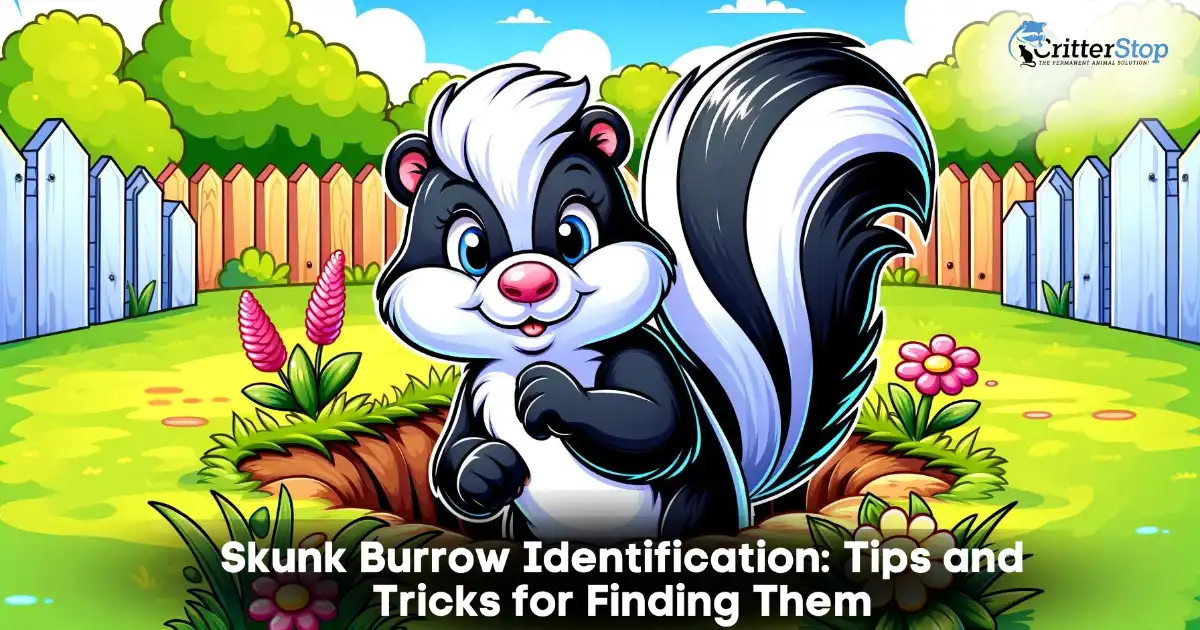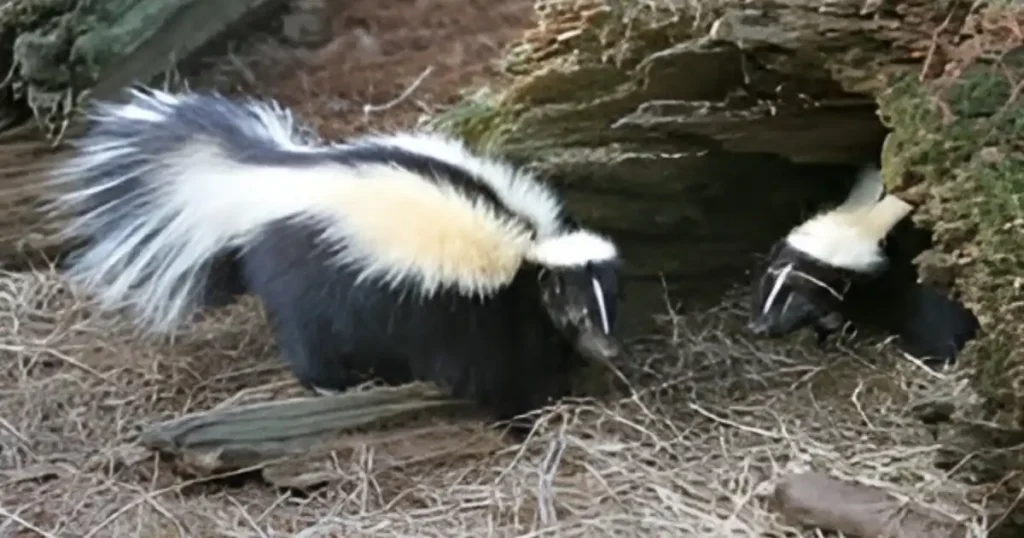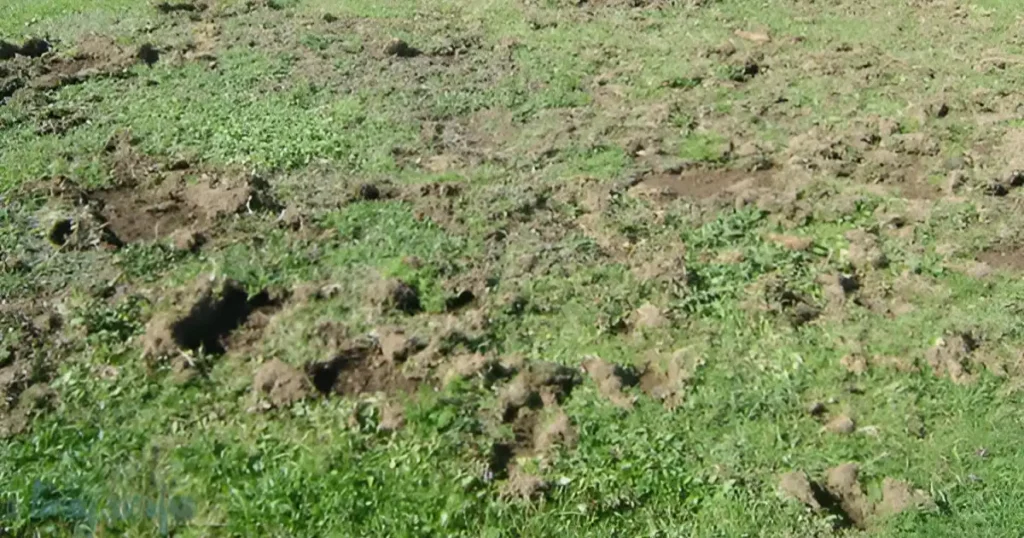
Skunks’ potent odor and black and white coloring, and stubby legs characterize them. However, these creatures are also known for their ability to excavate lairs. They do this for a variety of reasons, including shelter, protection, and food storage. Identifying them can be important for a variety of reasons, including pest control, wildlife management, and understanding the behavior of these critters.
They can be identified by many different characteristics. One key characteristic is the size of the den entrance. A den typically has a small entrance that is about the size of a grapefruit. Additionally, dens often have a distinct odor, which can be used to identify their location. Some other characteristics may include the presence of claw marks on nearby trees or rocks, as well as the presence of tracks in the surrounding area.
Skunks are nocturnal critters, much like a raccoon. They are known for their distinct odor and black and white striped fur. They inhabit both North and South America and are known to den underground for shelter and protection. They can also do so to find food, such as grubs. Understanding their behavior is important when identifying their lairs and habitats.
These creatures prefer habitats that provide them with easy access to food and water sources. They can be found in a variety of environments including forests, grasslands, and suburban areas. Abandoned buildings, sheds, and other man-made structures are some more places where skunks dig and can take up residence.
Skunks dig well and are known to create lairs underground. Dens are typically found in areas with loose soil such as under decks, sheds, and porches. Open fields and wooded areas are some other places where they may create their homes.
Striped skunk lairs can be identified by their size and shape. They are typically 6-8 inches in diameter and have a hole at the entrance. They may also create multiple entrances and exits to their dens. It is important to note that these can be dangerous as they may collapse, causing injury to both humans and critters.
In conclusion, understanding skunk behavior is important when identifying their lairs and habitats. These critters prefer habitats with easy access to food, such as small animals and grubs, and water sources and are proficient diggers that create homes underground. Dens can be identified by their size and shape, but it is important to exercise caution as they can be dangerous.

Some of their most famous characteristics are that they are nocturnal animals and have a distinctive odor. Skunks burrow underground where they live, raise their young skunks, and where they stay when they enter a state of torpor during the winter. Identifying these lairs can help determine the particular area where these critters are present.
They are typically 4 to 6 inches in diameter and can be up to 20 feet long. They are usually located in areas with soft soil such as gardens, lawns, or under porches. A skunk den is often identified by the presence of a small hole in the ground. The hole is usually surrounded by dirt that has been dug out by the creature with its front paws.
These critters tend to dig their lairs in areas with cover such as a tree, bushes or tall grass. They also prefer areas near a water source such as a stream or pond. These lairs can be found in both rural and urban areas. In rural areas, they may dig their homes in fields or along fence lines. In urban areas, they may dig their homes under sheds, decks, or other structures, or enter crawl spaces.
Overall, identifying these lairs can be useful for determining the presence of these critters in a particular area. It is important to be cautious when approaching a den dug by these critters as they are known to spray when they feel threatened. If you suspect one of these critters is living in a lair on your property, it is recommended to contact a professional wildlife removal service to effectively and humanely remove the animal.
Skunks are nocturnal critters that are well-known for their powerful spray and unique black and white hair. Their capacity to build lairs, which they utilize for shelter and rearing their young, is another well-known trait. There are a few indicators to watch out for if you think these critters may be in your yard.
One of the most obvious signs is the presence of their homes. They are excellent diggers and can create lairs that are up to 10 feet long and 3 feet deep. You can usually find these dens in areas with dense vegetation, such as under a tree, under bushes or in the corners of yards.
Another physical indicator is the presence of their droppings, which are typically about 2 inches long and 1/2 inch in diameter. Skunk droppings are often found near their homes or in areas where they have been feeding.
Skunks are primarily nocturnal critters like raccoons, so if you see one during the day, it may be a sign that it is sick or injured. These critters are also known for their distinctive odor, which they use to defend themselves against predators. If you smell a strong, musky odor in your yard, it may be a sign that they are present.
Another behavioral clue to look out for is the presence of holes or scratches in your lawn or garden. These critters are omnivores and will eat a variety of foods, including insects, small rodents, and plants. They will often dig holes in search of food, which can be a sign of their presence.
In conclusion, if you suspect that skunks are present in your yard, there are several signs to look out for. These include the presence of lairs, droppings, strong odors, and holes or scratches in your lawn or garden. If you do encounter a skunk, it is important to give it plenty of space and avoid startling it, as it may spray in self-defense.

These critters are known for their ability for digging holes, which can cause significant property damage and threaten the security of homeowners. Understanding the impact of these lairs is essential for homeowners to take necessary measures to prevent or mitigate damage.
Skunks digging burrows can cause extensive property damage, especially if they are located under a house or other structures. Their homes may cause structural harm by weakening the house's foundation, leading to costly repairs. They may also dig their homes in gardens and lawns, which can damage plants and make it difficult to maintain the landscape.
These critters are generally not aggressive, but they can pose risks to human safety if they feel threatened or cornered. These critters' holes may be located near walkways, driveways, or other areas where people may accidentally step on them, leading to falls and injuries. Skunks living near people may cause transmission of diseases, such as rabies, if they are bitten or scratched.
To assess the impact of this, homeowners should look for signs of burrowing activity, such as them digging holes in the ground or damage to property. They should also be aware of the risks associated with these lairs and take necessary measures to prevent or mitigate damage. This may include installing fencing or barriers to prevent them from accessing the property, filling in their lairs, or contacting a professional pest control service for assistance.
Overall, homeowners need to be proactive in identifying and addressing these nests to prevent property damage and ensure the safety of themselves and their families.
Skunks are known to lair in yards and gardens, causing damage to the landscape and potential health hazards. Prevention and control measures are necessary to keep these critters away from properties. Here are some techniques to prevent and control them:
Exclusion techniques are a good way to prevent skunks from burrowing in yards and gardens. Homeowners can use exclusion techniques to seal off potential entry points to deter them from accessing the property. The following are some exclusion techniques that may deter them from entering your property:
Repellents and deterrents can be used to keep skunks away from properties. These products work by emitting odors or sounds that these critters find unpleasant. The following are some repellents and deterrents that you can use:
By using exclusion techniques, repellents, and deterrents, homeowners may be able to prevent and control these lairs in their yards and gardens.

Identifying burrows can be a tricky task that requires a certain level of expertise. It is also key to comprehend there are legal and ethical considerations that must be taken into account when identifying these lairs.
In many states, it is illegal to trap or kill skunks without a permit, although Texas isn’t one of them. This is because these critters are considered a protected species and are essential to the ecosystem. Thus, it's crucial to check with your local wildlife agency to determine the regulations in your area before attempting to identify or remove them.
When it comes to identifying these lairs, it's important to use humane skunk removal practices. This means that you should avoid using lethal traps or poisons that can harm the skunks or other wildlife in the area.
Instead, it's recommended to use live traps that allow you to safely capture and relocate the skunks to a more suitable habitat. Additionally, it's important to seal off the lair entrance once the skunks have been relocated to prevent other animals from moving in.
Overall, by following wildlife regulations and using humane removal practices, you can safely and ethically identify and remove them without causing harm to the critters or the environment.
Identifying skunk burrows can be a challenging task, especially for those who lack experience in animal control and skunk removal. While there are several methods to identify these lairs, it is not always easy to determine the location and extent of a lair. It may be needed, in some instances, to hire a professional to assist with their identification and removal.
A professional can provide valuable insight into the location and extent of these nests. They possess the required devices and tools to identify and remove these lairs safely and efficiently. If you are unsure about the location and extent of a lair or if you are unable to remove the nest on your own, it is best that you contact a professional wildlife removal company tyo effectively get rid of the creature.
When choosing a professional service to assist with the identification and removal of the nest, it is important to select a reputable company with experience in animal control. Look for a company that is licensed and insured, and has a proven track record of successful skunk burrow removal.
It is also important to consider the cost of the service. While it may be tempting to choose the cheapest option, it is important to remember that quality service comes at a price. Choose a service that offers competitive rates and provides a detailed estimate of the cost of the service.
In summary, if you are struggling to identify and remove these nests, it may be necessary to hire a professional. Choose a reputable service with experience in animal control and competitive rates to ensure that the job is done safely and efficiently.

Skunk nests can be a nuisance to homeowners, but it's important to handle them safely and humanely. Here are some tips for DIY management:
Removing a skunk lair can be dangerous if not done properly. It's important to take precautions to avoid being sprayed by these critters and to prevent harm to the animals. The following are some measures you can take:
Once the lair is removed, it's important to restore the affected areas to prevent future lairs from being created. Here are some steps to restore the area:
By following these steps, homeowners can safely and humanely manage these nests on their property.
If skunks have made your property their home, Critter Stop is here to help! We are a fully licensed and insured professional wildlife removal company with a five-star reputation and glowing reviews, servicing commercial and residential customers in Texas. Contact Us at (214) 234-2616 and book your free inspection and estimate today!
They are typically 3 to 4 inches in diameter and have a shallow depression around the entrance. They are usually found in soft soil or under debris such as logs or rocks. The lair itself is often dug at an angle, with a chamber at the end.
They are usually larger than other animal holes, such as those made by chipmunks or rats. They also have a distinct odor due to the presence of skunks. Additionally, these lairs often have a shallow depression around the entrance.
They are usually larger than those of other burrowing critters, such as chipmunks or rats. They are typically 3 to 4 inches in diameter.
The presence of these nests can be indicated by the smell of these critters, as well as by the presence of shallow depressions around the entrance to the lair. Skunks may also leave tracks or scat in the area.
They are usually larger than those of chipmunks or rats, and they have a distinct odor due to the presence of skunks. Additionally, these lairs often have a shallow depression around the entrance.
They are typically shallow, with a depth range of 2 to 4 feet. However, they may occasionally dig deeper burrows if necessary for shelter or protection.
Visit our Critter Library and learn more about our furry friends